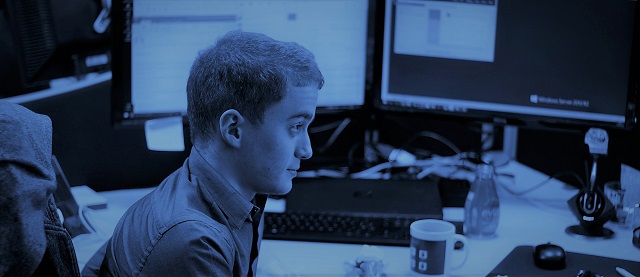
Social distancing. In spring 2020, these two words changed the world. Many businesses had to utterly reinvent their way of working and the great morning commute to chrome and glass office was replaced by a decidedly shorter journey to home workstations.
Senior support engineer Yacer Sellam is one of the Intersys team helping businesses make that transition as seamless as possible by providing remote IT support and consultancy. We asked him for his take on how organisations have coped during this seismic transition and what they’ve got right — and wrong.
We’ve also asked him to stick his neck out and predict what the office environment will look like in years to come.
Yacer, what kind of remote IT support have you provided in the wake of Covid-19?
The brief for remote working is: ‘I want to be able to do exactly what I can do in the office at home.’ So it is about giving a client all the infrastructure they enjoy in the office, without their being there physically. And making the transition as seamless as possible.
In practice, what has that involved?
Initially, there was an influx of calls asking for virtual private network (VPN) access, which allows users to secure their office networks and access files remotely. This was particularly the case with smaller clients who previously didn’t see a need for a VPN – but definitely do now!

Says Yacer, ‘Try to ensure the home working environment mirrors the office one as much as possible. The infrastructure should look and act the same for users.’
Then there were the more ‘home grown’ issues. People would tell me they couldn’t access a resource remotely because their home network was blocking it. We’ve had to modify clients’ home routers to ensure a home set up works. Generally, we’ve had to get more involved in looking at people’s personal devices to help them function more than we ever have done before.
Helping businesses with a home set up has sparked an interest in looking for new tech solutions too. For instance, once a client has a cloud service such as Microsoft Office 365, they ask for a lot more, because they can see what is available to them – things like SharePoint and Microsoft Teams. The transition is helping educate users and helping them see the potential of applications they haven’t even considered before.
We’ve recently migrated to a new helpdesk system which has really helped improve communication and allows for more effective information sharing. The positive feedback has shown how much our customers appreciate a swift and proactive response.
What have been the biggest struggles for businesses?
Our clients haven’t really struggled. They typically have Microsoft DirectAccess, which allows people to access private network resources remotely using the Internet; or they have a VPN that was already configured. All they had to do was take laptops home and keep working. We also recommended they chose laptops that can be docked, to provide a single connection point for using a mouse, monitor and keyboard. It means they can get all the benefits of a desktop set up, but one that is easier to move around. We also try to ensure they have the option to expand their set ups for more comfortable working – for instance, an option for multiple screens.
Of course smaller companies may not have the time or budget to give IT as much consideration as larger counterparts. Some might not have business continuity planning (BCP) in place that covers pandemic scenarios, or ISO certifications to help ensure data protection compliance, so in that sense they are potentially more vulnerable. But they are also more adaptable than larger organisations and can make the transition quickly. All of the hardware we install on client sites can usually be accessed remotely and offers features to expand on, if they want that.
What about the wider industry? What mistakes have you seen businesses make when creating a remote working strategy?
A lot of people panicked and set up remote access, but didn’t look at security too much. A report by the specialist search engine Shodan suggested a 60% increase in open remote desktop protocol (RDP), which is bad because an RDP machine or server is only protected by a username and password. The protocol also has a history of being exploited, so it’s just a bad decision overall.

Taking the leap. Says Yacer, ‘Businesses will become more open to working from home — it’s been proven as a method. Some organisations have even realised a VPN was all they needed to make the transition and benefit from this new flexibility.’
It’s critical that businesses ‘reduce the attack surface’, as we say in the industry; or, in layperson’s terms, reduce areas open to exposure to malicious attack. Make sure that when accessing the corporate network an encrypted channel is used. VPN does that. Also, ditch old and deprecated VPN protocols and ensure your firewall or VPN appliance is up to date. If something is exposed on the internet, you want to make sure you have taken every measure to ensure it’s not exploitable.
What other tips would you give to businesses who still haven’t sorted their remote working adequately?
In IT terms, try to ensure the home working environment mirrors the office one as much as possible. The infrastructure should look and act the same for users, so they aren’t jumping through hoops because the system is different, isn’t working as well, or is slower. The more unfamiliar the setup is, the more mistakes people will make. It should be as seamless as possible.
Away from the IT side for a moment, what are your thoughts about the big societal changes this new way of working is bringing?
These changes have been the biggest challenge. You have to communicate more, and more clearly. That might be in better-constructed emails with no room for ambiguity, or daily conference calls. It’s about making sure your team is still very much a team; you have to ensure you are proactively communicating with each other.
The pandemic has been a tragedy for many people, personally and financially. But can you draw out any positives from a business and IT point of view?
Businesses will become more open to working from home. Previously, some were quite selective about who could do that, for instance by having a senior-staff-only work-at-home policy. Now everyone is working from home and it’s been proven as a method. Some organisations have even realised a VPN was all they needed to make the transition and benefit from this new flexibility.
On a related point, the pandemic has greatly benefited some businesses in terms of their IT infrastructure. They have given the go ahead for upgrades and ensured all is working at 100% capacity. Before the pandemic, they might have said, ‘We don’t need that right now — maybe next quarter or next year.’ Now they are actively asking for work to be done.
When they move their infrastructure from the office environment to home, the chinks in the armour are exposed and they are proactively repairing and upgrading.
What do you think the future will look like for businesses, in terms of working spaces and IT?
Right now, I am helping a US company with cybersecurity. They told me their office space is just that: a space for employees to work. It doesn’t have servers or IT infrastructure to speak of – it is just a place for employers to come in and work. Essentially, they could work exactly the same way from home. In my view, that’s how a business should function in the post Covid-19 world – with absolutely no dependency on location. If organisations are designed that way from the get-go, they will have a better outcome during unprecedented times.